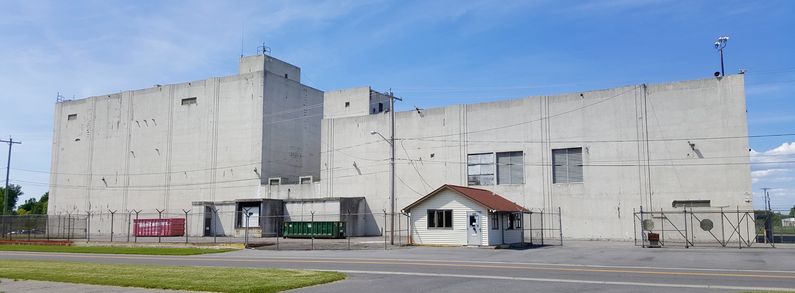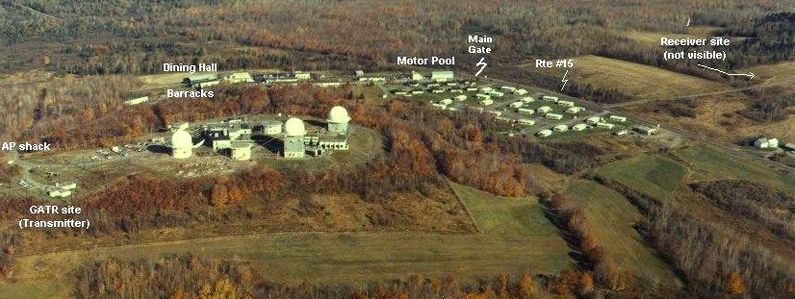Charleston Air Force Station
|
Charleston Air Force Station (1952-1980) - A Cold War Air Force Radar Station first established in 1952 near Charleston, Penobscot County, Maine. Named Charleston Air Force Station after the location. Initially assigned a Permanent ID of P-65 and later a Sage ID of Z-65. Abandoned in 1980.
HistoryEstablished on 1 Jan 1951 and became operational on 1 Jun 1952 at Charleston Air Force Station manned by the 765th AC&W Squadron. The station initially had both a Ground-Control Intercept (GCI) and an early warning mission. The early warning mission involved tracking and identifying all aircraft entering their airspace while the GCI mission involved guiding Air Force interceptors to any identified enemy aircraft. Controllers at the station vectored fighter aircraft at the correct course and speed to intercept enemy aircraft using voice commands via ground-to-air radio. Initial equipment included the FPS-3 search radar and an FPS-5 height-finder radar. The FPS-5 was replaced in 1957 with an FPS-6 and a second one was added in 1958. The FPS-3 was also upgraded to an FPS-20 in 1958. This was the starting configuration for entry into the SAGE system, the FPS-20, and two FPS-6s. SAGE System TransitionThe transition of the manual GCI system to the automated SAGE system began with the installation of the FST-2 coordinate data transmitter and search radar upgrades. The FST-2 equipment digitized the radar returns and transmitted the digital returns to the SAGE direction center. Under the SAGE System, interceptor aircraft were directed to their targets by the direction center computers and controllers, greatly reducing the need for local controllers and equipment at every radar station. The FST-2 was a very large digital system using vacuum tube technology. Over 6900 vacuum tubes were used in each FST-2 requiring 21 air-conditioned cabinets, 40 tons of air conditioning, 43.5 kva of prime power, and usually a large new addition to the operations building. The FST-2B modification added two more cabinets but with newer solid-state (transistor) technology to process coded responses from aircraft transponders. SAGE System Operation
The site began operation as a SAGE site in May 1959 initially feeding the Topsham SAGE Direction Center DC-05. The search radar was upgraded to an FPS-27 in 1963 and an FPS-26A height-finder radar was installed. In 1966 the FPS-26A was converted to an FSS-7 SLBM detection & warning radar operated by Det 6, 14th Missile Warning Squadron. In 1969 the Topsham SAGE Direction Center DC-05 closed and control of Charleston AFS switched to the Hancock SAGE Direction Center DC-03 and the 21st Air Divison where it remained until the site closed. Gap Filler RadarsCharleston AFS was responsible for the maintenance of two remote unattended gap-filler radar sites. The unattended gap filler sites were placed in locations where the main search radar lacked coverage. These sites were equipped with short range FPS-14 or FPS-18 search radars and FST-1 Coordinate Data transmitters that sent digitized radar target data to a SAGE direction center and to the main radar site. Both the radar set and the FST-1 were dual channel to increase site up time. Maintenance teams were dispatched for regularly scheduled maintenance or when fault indicators on the FSW-1 remote monitoring equipment suggested the site had problems. The FSW-1 also allowed remote operation of specific functions such as channel changes for the radar and for the FST-1, it also allowed remote operation of the diesel generators at the gap filler site. The Charleston AFS gap-filler radars were located at Topsfield, ME, and Sedgwick, ME.
BUIC SystemCharleston AFS became a BUIC I GCI site 1 Mar 1963 and went operational as a BUIC II site on 1 Mar 1966. It was selected as a BUIC III site and in December 1969 the 765th Radar Squadron (SAGE) became the 765th Air Defense Group (BUIC). The BUIC III system provided a backup for a SAGE direction center and provided the ability to display sector-wide radar data on consoles for local weapons controllers. The system duplicated the functionality of the vacuum tube direction center computers with more up-to-date computers and replaced the FST-2 with a more up-to-date coordinate data transmitter, the FYQ-47. The FST-2 at Charleston AFS was loaded on a flatbed truck, taken to Brunswick NAS, and scrapped. As the threat from a Soviet bomber fleet lessened the decision came to mothball the BUIC system in 1974. Charleston AFS and the 765th were deactivated 30 Sep 1980.
Note: Sources differ on some of these dates and no dates are available for others See: AngleFire - Charleston AFS Commanders and Charleston AFS documents on Radomes.org. Physical PlantThe physical plant of the site was divided into the main site, a cantonment area, a housing area, and a radio site. The main site housed the operations buildings, the radar towers, and the backup generators. The cantonment area housed the five enlisted barracks, the bachelor officer's quarters, the orderly room, the dining hall, the motor pool, and other support buildings. Apart from the main site was a small 37 unit housing area for married personnel. The first 9 housing units were built about 1957 and the additional 28 units were added in 1964. A separate radio site housed the radio equipment for directing aircraft intercepts. Like most early radar stations, Charleston originally had a radio transmitter site and a separate radio receiver site used by local controllers for voice direction of fighter interceptors to their targets. With the SAGE System, the SAGE Direction centers had the primary task of directing intercepts and the local radio sites were reconfigured, usually into a single site that was known as the Ground to Air Transmitter Receiver (GATR) site. The GATR site communicated with the interceptors from either the local site or the SAGE direction center via voice commands and/or a digital data link.
Current StatusNow Mountain View Youth Development Center near Charleston, Penobscot County, Maine. The housing area has been completely removed. Most of the cantonment buildings remain, repurposed for the detention facility. Most of the main operations site buildings and towers remain, in a deteriorated condition and unoccupied. The site was visited on 26 May 2018 but a request for access to the upper site was denied. Not much can be seen from public roads.
See Also:
Sources:
Visited: 26 May 2018
| |||||||||||||||||||||||||||||||||||||||||||||||||||||||||||||||||||||||||||||||||||||||||||||||||||||||||||||||||||||||||||||||||||||||||||||||||||||||||||||||||||||||||||||||||||||||||||||||||||||||||||||||||||||||||||||||||||||||||||||||||||||||||||||||||||||||||||||||||||||||||||||||||||||||||||||||||||||||||||||||||||||||
